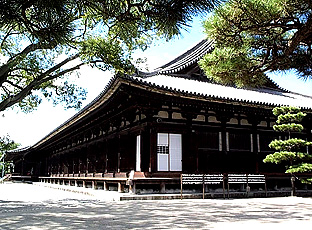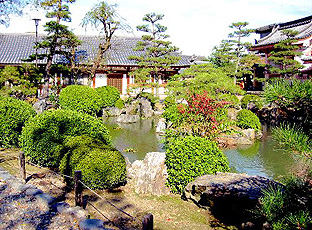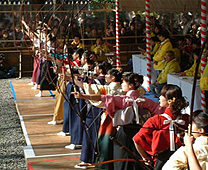
Travel Guide


Introduction
Sanjusangendo Temple is a Buddhist temple in Higashiyama District of Kyoto. Officially known as "Rengeo-in" (蓮華王院), or Hall of the Lotus King, Sanjusangendo Temple belongs to and is run by the Myohoin Temple, a part of the Tendai school of Buddhism. The temple is designated a National Treasure.
Sanjusangendo Temple was originally built by Taira no Kiyamori at the request of retired emperor Go-Shirakawa in 1164 and dedicated to the Bodhisattva Kan’non.
The temple complex contains buildings rich in history as well as architectural beaut but suffered a fire in 1249 and only the main hall was rebuilt in 1266. That structure has remained unchanged for 700 years since then with four great renovations during that time. The temple hall is with 120 meters Japan's longest wooden structure and is made in the Wayo (Japanese) style. The name Sanjusangendo Temple (literally "33 intervals") derives from the number of intervals between the building's support columns, a traditional method of measuring the size of a building. The number 33 is sacred in Buddhism, for it is believed that Buddha saves mankind by disguising himself in 33 different forms.
Other than the main hall, the grounds contain beautiful examples of Japanese gardening, and some scattered trees that make for an atmosphere that feels of ancient Japan, an experience unique to temples in Kyoto. The courtyard outside the hall is quite serene and picturesque. The grounds are exceptional and worth taking a stroll through.
Other objects of note at the temple are the roofed earthen fence and South Gate, which are registered as Important Cultural Properties. They are associated with Regent Toyotomi Hideyoshi and reflect the aesthetics of the 16th century.
1,001 figures of Kan’non
The temple features a huge hall containing 1,001 figures of Kan’non.
In the center of the main hall sits a large, wooden statue of a 1000-armed Kan’non (National Treasure) that is flanked on each side by 500 statues of human sized 1000-armed Kan’non (Important Cultural Properties) standing in ten rows. Together they make for an awesome sight. Among the standing statues, 124 were carved in the 12th century when the temple was founded, and the remaining 876 were made in the 13th century when the temple was renovated.
1000-armed Kan’non is formerly called Juichimen-senju-sengan Kanzeon (eleven-headed, thousand-armed, thousand-eyed Kan’non). 1000-armed Kan’non are equipped with 11 heads to better witness the suffering of humans and with 1000 arms to better help them fight the suffering. Note that the actual statues have only 42 arms each. Subtract the two regular arms and multiply by the 25 planes of existence to get the full thousand.
Around the 1000 Kan’non statues stand 28 statues of guardian deities who protect the Buddhist universe. They represent Kan’non's disciples and embody various virtues. There are also two famous statues of Fujin, the god of wind and Raijin, the god of thunder who carries circular drums on his back and makes thunder by beating on his drums.
The 28 guardian deities stand in front of the Buddhist Kan’non have their origins in Sanskrit texts of Hinduism. These ideas came to Japan through China, and the presence of both Hindu and Buddhist deities at Sanjusangendo Temple in Kyoto suggest various theories of the origin and spread of the spiritual and cultural ideas from India to east Asia.
Travel Advice
Sightseeing
- In order to protect the historic and cultural relics, taking pictures is strictly prohibited inside of the main hall.
- Each Kan’non statue is hand-carved, all of them have difference face and facial expression. It is said visitors can find the one of which the face is similar to him or her.
Toshiya
It is said that Toshiya originated in Hogen War (around 1156), when Genta Kabusaka in Kumano shot through the hallway with neya (arrows for actual battle) under the eaves of Sanjusangendo Temple, but it is just a legend because the temple did not exist at that time.
In the beginning, archers fired arrows from the southern end of the veranda to the northern end where a curtain-like ornament was erected as a target. The contest gained popularity during the Edo period and by the late 17th century competitions between participants from the Owari and Kishu provinces were drawing big crowds. The Toshiya would later be used as a motif in stories and film.
In 1861, after 255 years, the Toshiya ceased being held, but a contest based on the Toshiya called Omato National Tournament, or Festival of the Great Target, still continues today, drawing roughly 2,000 participants from throughout Japan.
Events
Rite of the Willow
In January, the temple has an event known as the Rite of the Willow (柳枝のお加持), where worshippers are touched on the head with a sacred willow branch to cure and prevent headaches.
Omato National Tournament
 Sanjusangendo Temple is the famous place for a popular archery tournament known as Omato National Tournament. Sanjusangendo Temple is historically the popular place for Toshiya (通し矢) which is held during Edo period. Every year roughly 2,000 young people compete in the tournament, the men in their dark blue hakama, or male kimono, the women in their finest coming of age furisode, a kimono for an unmarried woman. Both men and women must be newly minted adults: in Japan this means 20 years old. The second precondition for participation is that the competitors must have attained the first dan, or belt, in Japanese archery. Archers shoot arrows into targets approximately 50 - 100 centimeters in diameter and 60 meters (198 feet) away at the opposite end of the veranda. The Omato National Tournament is held annually on the second Sunday in January.
Sanjusangendo Temple is the famous place for a popular archery tournament known as Omato National Tournament. Sanjusangendo Temple is historically the popular place for Toshiya (通し矢) which is held during Edo period. Every year roughly 2,000 young people compete in the tournament, the men in their dark blue hakama, or male kimono, the women in their finest coming of age furisode, a kimono for an unmarried woman. Both men and women must be newly minted adults: in Japan this means 20 years old. The second precondition for participation is that the competitors must have attained the first dan, or belt, in Japanese archery. Archers shoot arrows into targets approximately 50 - 100 centimeters in diameter and 60 meters (198 feet) away at the opposite end of the veranda. The Omato National Tournament is held annually on the second Sunday in January.
Visit
| Address | 657 Mawari-cho, Sanjusangen-do, Kyoto-shi, Kyoto | |
| Phone | 075-561-0467 | |
| Admission | Adult: 600 yen (Groups 550 yen) Student: 400 yen (Groups 350 yen) Child: 300 yen (Groups 250 yen) |
Adult: over 18 Student: 12 to 17 Child: 6 to 11 Groups: over 30 |
| Hours | 08:00 to 17:00 April 1 to November 15 09:00 to 16:00 November 16 to March 31 |
Entry until 30 minntes before closing |
| Closed | Open 7 Days a Week | |
| Duration | 30 minutes | |
| Getting There | By Train 5 minutes ride by City Bus No.100, 206 or 208 bound for Kyoto from JR Kyoto Station to the Museum Sanjusangendo Temple-mae bus stop, then walk approximately 1 minute. 7 minute walk from Shichijo Station on Keihan Electric Railway Keihan Honsen. By Car Take Meishin Expressway to the Kyotohi-gashi exit. It is approximately 5 kilometers 15 minutes from exit. |
|
| Parking | Free parking available | |

